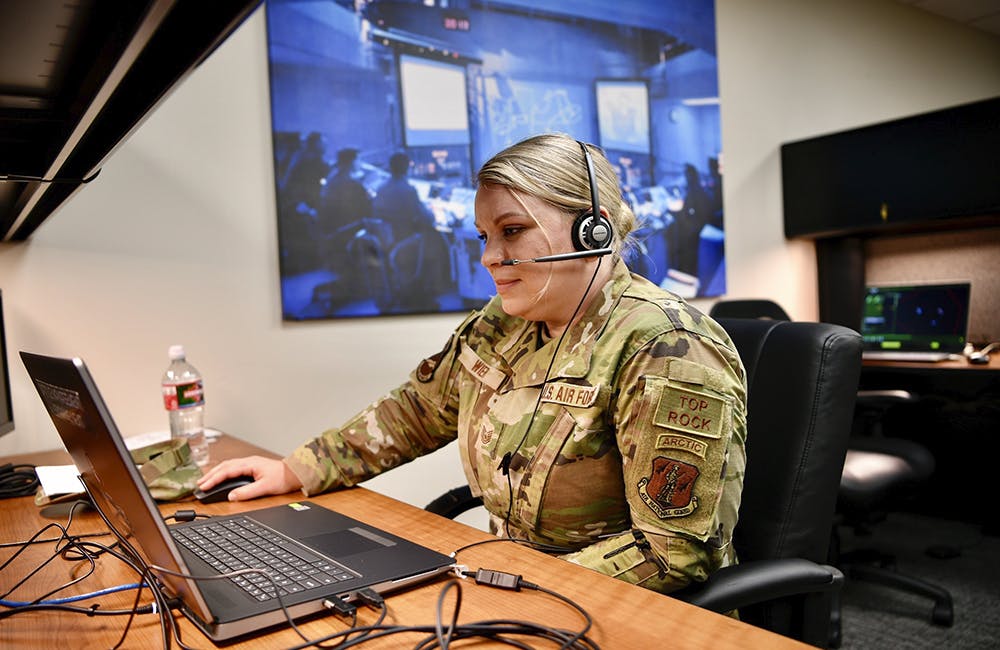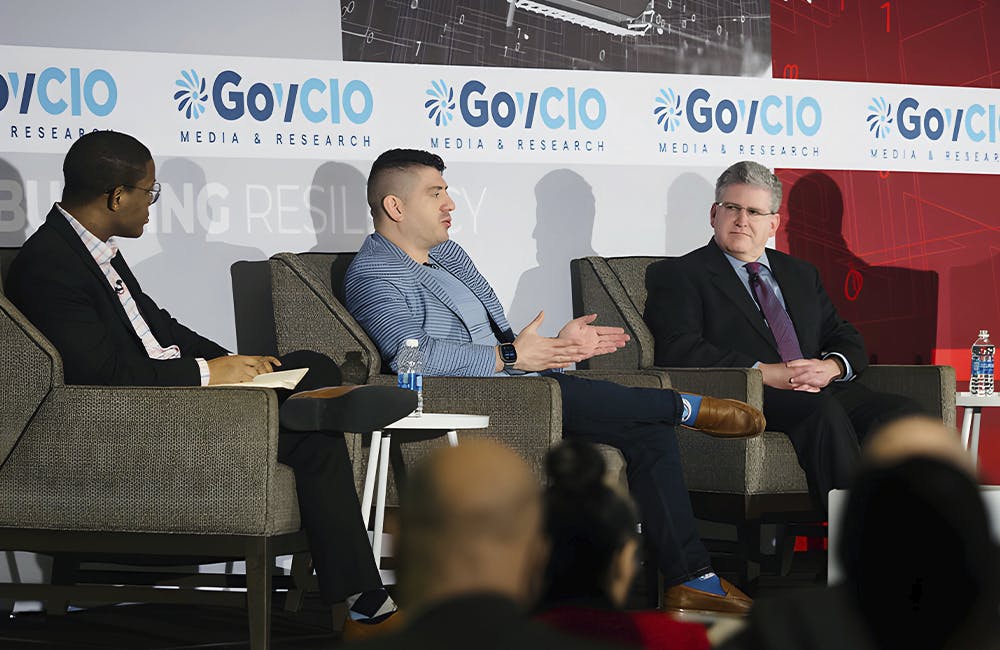Mission and Culture Will Drive AI Excellence at DOD, Top AI Leaders Say
New DOD Chief Digital and AI Officer Craig Martell said the DOD mission lured him away from Lyft and now wants to develop a culture that appeals to new AI talent as well.

The Defense Department cited culture as a major hurdle to implementing the department’s AI strategy and pulling ahead of China and Russia in the AI race, top defense leaders said at the DOD Digital & AI Symposium Tuesday.
“The government has trouble getting people into its offices because of the way it operates,” said Eric Schmidt, a commissioner for the National Security Commission on Artificial Intelligence, during a symposium panel Tuesday. “You identify a young person who takes 18 months to get their security clearance and they need their clearance to do their job. The bizarre baroque way in which personnel are handled … we worked hard on this without much success. Not even the president could fix the HR system in DOD.”
Tangential to the culture problem is competing with Silicon Valley for top AI talent. Schmidt and Craig Martell, DOD’s new chief digital and AI officer, both believe the DOD mission will draw talent, not salaries.
Enticing young college graduates to work in AI at DOD can also jumpstart their careers ahead of peers that go directly to Silicon Valley, Schmidt added.
“If you think about the DOD, it’s the hardest enterprise problem and one of the hardest data problems in the world,” he said. “You do that for a couple years and now you’re dealing with a more flexible working environment, but you’re trained on Big Data and Big Data problems.”
Martell said the mission is what originally drew him to the CDAO position.
“I’m doing it because of the mission,” he told Schmidt at the symposium. “It’s extremely important we get this right, and there aren’t a lot of folks with the intersection of AI and government background. When the deputy secretary of defense calls you up and asks you to take this job, you have to think really hard about why you wouldn’t take this job.”
William Streilein, CTO within the office of the DOD CDAO and former CTO of DOD’s Joint Artificial Intelligence Center (JAIC), said the United States’ AI advantage is “eroding,” in part due to a lacking AI culture and talent pool.
“I think the No. 1 problem is culture,” he said during a symposium panel Tuesday. “I think the other things will follow if we get the culture right. The main obstacle is a culture accepting of change while maintaining our mission goals.”
Margarita Konaev, deputy director of analysis at the Center for Security and Emerging Technology, echoed Streilein’s concerns and said DOD’s sprawling, bureaucratic structure can impede a robust AI culture from being realized.
“There are serious challenges that remain … [such as] a risk-averse culture, the preference to continue with the path we’re already in and the lack of incentives to promote AI and analytics and data and foster a more experimental culture,” she said during a symposium panel Tuesday. “The contrast is surprising in a sense because you have a military at the strategic and tactical level that is ready to learn and experiment and learned to learn from previous engagements and conflicts. At the same time at the organizational level, we have a lot more static structure that tends to favor the past as opposed to the future of war.”
As the DOD CDAO ramps up operations after absorbing the JAIC, the Defense Digital Service and DOD’s ADVANA teams, developing a healthy culture may be Martell’s biggest challenge, said Martijn Rasser, senior fellow and director of the Technology and National Security Program at the Center for New American Security.
“I think that’s the biggest challenge for the CDAO, but also the biggest opportunity,” he said during a symposium panel Tuesday. “We don’t know exactly what the right culture is. We know what’s currently in place is not what it needs to be. Figuring out what that culture should look like will be a fascinating exercise. I think the department has the human capital it needs to use AI well, so I don’t see that as much as a problem, there’s still changes that need to be made in terms of attracting and retaining talent, but there are a lot of really talented people already in place that are probably underutilized.”
This is a carousel with manually rotating slides. Use Next and Previous buttons to navigate or jump to a slide with the slide dots
-

AI Foundations Driving Government Efficiency
Federal agencies are modernizing systems, managing risk and building trust to scale responsible AI and drive government efficiency.
40m watch -

Navy Memo Maps Tech Priorities for the Future Fight
Acting CTO’s memo outlines critical investment areas, from AI and quantum to cyber and space, as part of an accelerated modernization push.
5m read -

DOD Can No Longer Assume Superiority in Digital Warfare, Officials Warn
The DOD must make concerted efforts to address cyber vulnerabilities to maintain the tactical edge, military leaders said at HammerCon 2025.
4m read -

New NSF Program Cultivates the Future of NextG Networks
The agency’s new VINES program looks to tackle key challenges like energy efficiency and future-proofing wireless tech.
21m watch -

DHA CDAO Spearheads Master Data Catalog to Boost Transparency
Jesus Caban plans to boost DHA's data maturity through a new master data catalog, governance frameworks and inventory of tech tools.
5m read -

Trump Orders Spark Government-Wide Acquisition Overhaul
As Trump pushes for a faster, simpler procurement system, agencies are leveraging AI and adapting strategies to meet new requirements.
5m read -

Inside Oak Ridge National Lab’s Pioneer Approach to AI
Energy Department’s Oak Ridge National Lab transforms AI vulnerabilities into strategic opportunities for national defense.
22m listen -

A Look at Federal Zero Trust Transformation
Recent developments from CISA and DOD show how government is advancing zero trust quickly.
20m read -

Modernization Strategies to Enable Energy Innovation
Lawrence Berkeley National Lab and Maximus experts explore the modernization strategies driving digital transformation and operational resilience within the energy sector.
33m watch -

DOI Must Modernize Energy to Win AI Race, Secretary Says
Doug Burgum links AI innovation to energy reform as DOI advances digital infrastructure and wildfire response under Trump’s tech agenda.
2m read -

NIST to Release New AI Cybersecurity Guidance as Federal Use Expands
NIST plans to release AI cybersecurity guidance within the year to support safe adoption as federal agencies expand use cases.
4m read -

Federal Zero Trust Forum
The Federal Zero Trust Forum brings together key technology leaders from across government to explore practical strategies and share lessons for advancing zero trust architecture.
Ritz Pentagon City | 1250 S Hayes St, Arlington, VA 22202
















